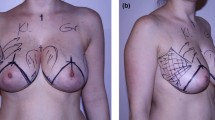Abstract
Background
More than100 techniques and variations of breast reduction have been published. In most, the principal differences involve the method of transpositioning the nipple–areola complex and the pattern of skin resection. Skin resection inevitably causes scarring, which has given rise to an ongoing debate over long scar techniques and short scar techniques. The debate would be mute if only the extent of the scar was evaluated: ideally, the shorter the better. However, this limitation of scar extension conditions other elements to be evaluated in the results. On the other hand, there is a great variety of clinical cases in which not only the volume must be considered, but also the degree of ptosis, the quality of the skin, the age, and, most importantly, the wishes of the patients.
Objectives
The objective of the crossed dermal flaps procedure was to obtain optimum volume, position, and shape of the breast; well-located good-quality scars as short as possible; and early satisfactory and long-lasting results.
Methods
Between June 1986 and June 2003 136 women underwent this procedure, performed under controlled hypotension (median arterial blood pressure, 60 mmHg). The technique is based on Wise-type skin marking associated with glandular resection in the lower and lateral poles, and transpositioning of the nipple–areola complex with a superior medial dermoglandular pedicle. Two rectangular areas under each cutaneous vertex are delimited, which will correspond with the future dermal flaps. These flaps are crossed, then fixed to the musculoaponeurotic chest wall, and the rest of the wound is sutured by planes in a conventional manner.
Results
Two patients (1.4%) experienced minimum cutaneous epidermolysis without dehiscence at the union of the vertical and horizontal sutures, which later healed by second intention without interference with the aesthetic result. Three cases (2%) showed partial and superficial necrosis of one of the areolae, but healed during the following 3 weeks without secondary surgery. In three patients (2%), hematomas developed, which were drained in the dressing room with no complications. One patient experienced thickening of the scar. No infections were observed.
Conclusions
The authors believe the cross dermal flaps technique is safe and applicable to an extensive variety of cases. It is easy to execute and to teach, and therefore, those who are beginning to use inverted T techniques such as that described, can, from the beginning, diminish the incidence of short- and long-term complications such as dehiscence that lead to scarring at the convergence of the flaps and bottoming out of the inferior pole, with the horizontal scar displaced upward and an increase in the distance between the later and the nipple areola complex.





Similar content being viewed by others
References
Y Brühlman H Tschopp (1998) ArticleTitleBreast reduction improves symptoms of macromastia and has a long-lasting effect Ann Plast Surg 41 250
RE Finger G Vazquez GS Oren KS Given (1989) ArticleTitleSuperior medial pedicle technique for reduction mammaplasty Plast Reconstr Surg 93 471
M Hamdi M Greuse A DeMey MH Webster (2001) ArticleTitleA prospective quantative comparison of breast sensation after superior and inferior pedicle mammaplasty Br J Plast Surg 54 39 Occurrence Handle10.1054/bjps.2000.3456 Occurrence Handle1:STN:280:DC%2BD3M3itlOmsw%3D%3D Occurrence Handle11121316
DJ Hauben (1985) ArticleTitleExperience and refinements with the superomedial dermal pedicle for nipple areola transposition in reduction mammaplasty Aesth Plast Surg 8 189 Occurrence Handle10.1007/BF01597524
D Hidalgo (1999) ArticleTitleImproving safety and aesthetic results in inverted T scars breast reduction Plast Reconst Surg 103 874 Occurrence Handle10.1097/00006534-199903000-00015 Occurrence Handle1:STN:280:DyaK1M7nsVKqtA%3D%3D Occurrence Handle10077078
D Hidalgo et al. (1999) ArticleTitleCurrent trends in breast reduction Plast Reconstr Surg 104 806 Occurrence Handle1:STN:280:DyaK1MzotlCguw%3D%3D Occurrence Handle10456536
AS Makki AA Grahem (1998) ArticleTitleLong-term results and patient satisfaction with reduction mammaplasty Ann Plast Surg 41 250
JC Orlando RH Guthrie (1975) ArticleTitleThe superomedial pedicle for nipple transposition Br J P Plast Surg 24 42
Author information
Authors and Affiliations
Corresponding author
Rights and permissions
About this article
Cite this article
de la Plaza, R., de la Cruz, L., Moreno, C. et al. The Crossed Dermal Flaps Technique for Breast Reduction. Aesth Plast Surg 28, 383–392 (2004). https://doi.org/10.1007/s00266-004-0370-4
Received:
Accepted:
Published:
Issue Date:
DOI: https://doi.org/10.1007/s00266-004-0370-4




